计算机之操作系统论文
有关计算机操作系统及应用的参考论文(2)
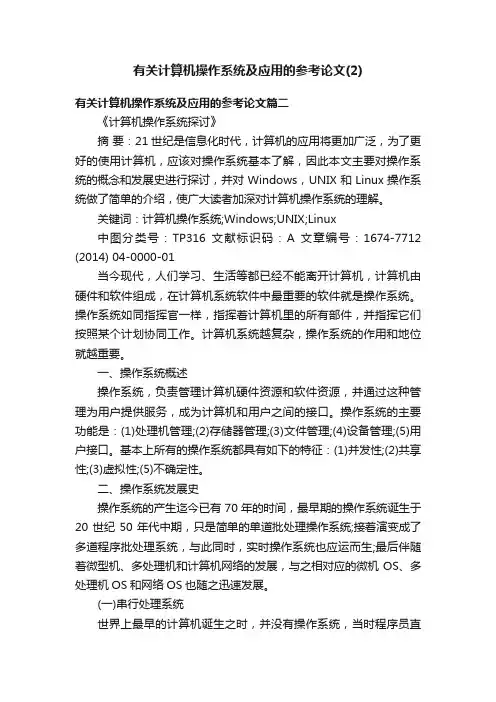
有关计算机操作系统及应用的参考论文(2)有关计算机操作系统及应用的参考论文篇二《计算机操作系统探讨》摘要:21世纪是信息化时代,计算机的应用将更加广泛,为了更好的使用计算机,应该对操作系统基本了解,因此本文主要对操作系统的概念和发展史进行探讨,并对Windows,UNIX和Linux操作系统做了简单的介绍,使广大读者加深对计算机操作系统的理解。
关键词:计算机操作系统;Windows;UNIX;Linux中图分类号:TP316 文献标识码:A 文章编号:1674-7712 (2014) 04-0000-01当今现代,人们学习、生活等都已经不能离开计算机,计算机由硬件和软件组成,在计算机系统软件中最重要的软件就是操作系统。
操作系统如同指挥官一样,指挥着计算机里的所有部件,并指挥它们按照某个计划协同工作。
计算机系统越复杂,操作系统的作用和地位就越重要。
一、操作系统概述操作系统,负责管理计算机硬件资源和软件资源,并通过这种管理为用户提供服务,成为计算机和用户之间的接口。
操作系统的主要功能是:(1)处理机管理;(2)存储器管理;(3)文件管理;(4)设备管理;(5)用户接口。
基本上所有的操作系统都具有如下的特征:(1)并发性;(2)共享性;(3)虚拟性;(5)不确定性。
二、操作系统发展史操作系统的产生迄今已有70年的时间,最早期的操作系统诞生于20世纪50年代中期,只是简单的单道批处理操作系统;接着演变成了多道程序批处理系统,与此同时,实时操作系统也应运而生;最后伴随着微型机、多处理机和计算机网络的发展,与之相对应的微机OS、多处理机OS和网络OS也随之迅速发展。
(一)串行处理系统世界上最早的计算机诞生之时,并没有操作系统,当时程序员直接和硬件打交道,具体流程是:首先程序员将已经穿孔的纸带(或卡片)装入内存,接着通过控制台或开关启动程序运行,最后当程序全部运行完毕,取出纸带(或卡片)和运算结果。
该系统严重地降低了计算机资源的利用率,形成了所谓的人机矛盾。
Linux操作系统毕业论文(1)
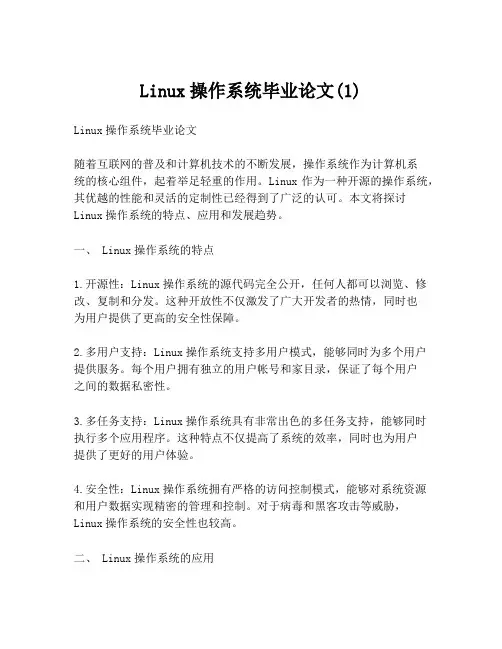
Linux操作系统毕业论文(1)Linux操作系统毕业论文随着互联网的普及和计算机技术的不断发展,操作系统作为计算机系统的核心组件,起着举足轻重的作用。
Linux作为一种开源的操作系统,其优越的性能和灵活的定制性已经得到了广泛的认可。
本文将探讨Linux操作系统的特点、应用和发展趋势。
一、 Linux操作系统的特点1.开源性:Linux操作系统的源代码完全公开,任何人都可以浏览、修改、复制和分发。
这种开放性不仅激发了广大开发者的热情,同时也为用户提供了更高的安全性保障。
2.多用户支持:Linux操作系统支持多用户模式,能够同时为多个用户提供服务。
每个用户拥有独立的用户帐号和家目录,保证了每个用户之间的数据私密性。
3.多任务支持:Linux操作系统具有非常出色的多任务支持,能够同时执行多个应用程序。
这种特点不仅提高了系统的效率,同时也为用户提供了更好的用户体验。
4.安全性:Linux操作系统拥有严格的访问控制模式,能够对系统资源和用户数据实现精密的管理和控制。
对于病毒和黑客攻击等威胁,Linux操作系统的安全性也较高。
二、 Linux操作系统的应用1.网络服务器:Linux操作系统被广泛用于搭建各种网络服务器,如Web服务器、邮件服务器、FTP服务器等。
这种应用领域不仅适用于企事业单位,而且适用于个人和小型团队。
2.桌面系统:Linux已经成为了一种成熟的桌面操作系统,如Ubuntu、Fedora、Debian等。
这些操作系统拥有丰富的应用程序和界面,可以满足大部分用户的各种需求。
3.嵌入式系统:Linux能够为嵌入式应用领域提供强大的支持,如路由器、IP电话、数字电视机顶盒等。
这些领域对于空间、功耗、安全性等多方面的要求较高,而Linux正是能够满足这些要求的操作系统。
三、 Linux操作系统的发展趋势1.云计算:随着云计算的普及,Linux作为云计算最为流行的操作系统之一,将会受到更广泛的应用。
linux操作系统课程论文
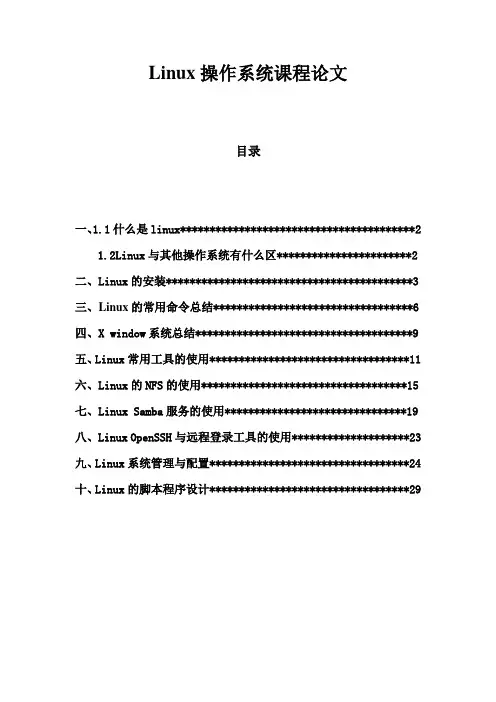
Linux操作系统课程论文目录一、1.1什么是linux****************************************21.2Linux与其他操作系统有什么区***********************2二、Linux的安装******************************************3三、Linux的常用命令总结**********************************6四、X window系统总结*************************************9五、Linux常用工具的使用**********************************11六、Linux的NFS的使用***********************************15七、Linux Samba服务的使用*******************************19八、Linux OpenSSH与远程登录工具的使用********************23九、Linux系统管理与配置**********************************24十、Linux的脚本程序设计**********************************29一、什么是linux呢?简单地说,Linux是一套免费使用和自由传播的类Unix操作系统,它主要用于基于Intel x86系列CPU的计算机上。
这个系统是由世界各地的成千上万的程序员设计和实现的。
其目的是建立不受任何商品化软件的版权制约的、全世界都能自由使用的Unix兼容产品。
Linux的出现,最早开始于一位名叫Linus Torvalds 的计算机业余爱好者,当时他是芬兰赫尔辛基大学的学生。
他的目的是想设计一个代替Minix(是由一位名叫Andrew Tannebaum的计算机教授编写的一个操作系统示教程序)的操作系统,这个操作系统可用于386、486或奔腾处理器的个人计算机上,并且具有Unix操作系统的全部功能,因而开始了Linux雏形的设计。
关于计算机系统的论文毕业论文范文2篇

关于计算机系统的论文毕业论文范文2篇关于计算机系统的论文范文一:计算机系统企业管理论文一、计算机在企业管理中应用的发展阶段通常情况下,mis阶段与dss阶段是同时进行的,在不断通过mis收集企业管理信息的过程中,dss系统就已经在不断地自动化或者半自动化地为决策者提供企业管理决策的依据,主要包括在一些信息数据的模型,表格,决策环境塑造上。
但是我们必须意识到,在企业管理决策上发挥统领作用的还在于人,不论是mis 还是dss仅仅是通过对信息的处理加工为企业管理者提供依据,以此来提高企业管理决策的质量。
二、计算机在企业管理中的应用领域简单地介绍了计算机系统在企业管理过程中经历的阶段,我们将更加全面地了解计算机系统在企业日常管理的过程中具体还发挥着哪些作用。
通常情况下,计算机系统在企业的日常经营管理过程中主要在以下几个方面发挥作用。
1.日常文字处理计算机技术的应用可以说在我们的日常生活中随处可见。
比如打印文件、编辑材料、制作表格等在企业中应用非常广泛。
计算机在日常做文字信息处理时与手写相比有很大的优势,手写较慢而且不工整,而计算机编写就要快的多,而且格式工整字迹清晰;手写出现错误时不容易修改,计算机操作出现错误时,只需要返回上一层就可以轻松解决,不留任何痕迹。
基于这些优势,企业当中计算机的应用非常广泛,也是企业发展的必然趋势。
计算机技术在21世纪迅速发展,很大程度上改变了以往的企业经营活动状态,例如,在企业报表的处理上,企业将更加依赖于计算机的处理,原因在于计算机处理的信息更加美观,并且相比于手工操作具有巨大的优势,计算机处理企业管理中的材料速度十分快,熟练的计算机操作者往往能以非常惊人的速度完成一份电子信息的处理。
同时,计算机处理的信息由于是电子化处理,可以保证格式的规范以及在修改过程中通过基于电子化的处理保证企业信息文件的美观、简洁。
日常生活中我们见到的打印文档、材料编辑与处理、表格的制作与修改都是通过计算机来完成的。
操作系统发展的现状论文
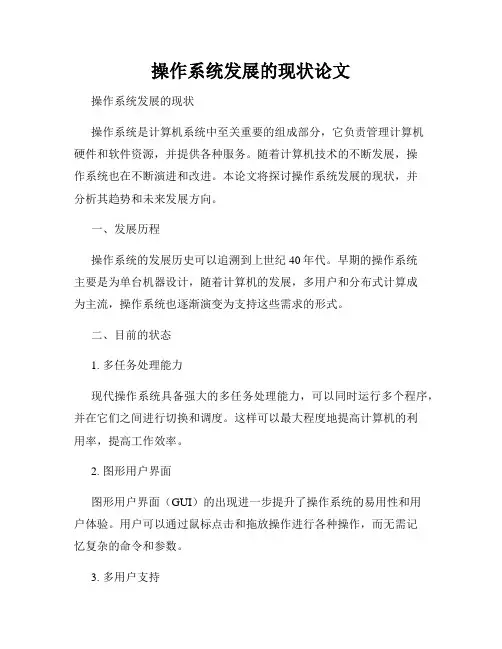
操作系统发展的现状论文操作系统发展的现状操作系统是计算机系统中至关重要的组成部分,它负责管理计算机硬件和软件资源,并提供各种服务。
随着计算机技术的不断发展,操作系统也在不断演进和改进。
本论文将探讨操作系统发展的现状,并分析其趋势和未来发展方向。
一、发展历程操作系统的发展历史可以追溯到上世纪40年代。
早期的操作系统主要是为单台机器设计,随着计算机的发展,多用户和分布式计算成为主流,操作系统也逐渐演变为支持这些需求的形式。
二、目前的状态1. 多任务处理能力现代操作系统具备强大的多任务处理能力,可以同时运行多个程序,并在它们之间进行切换和调度。
这样可以最大程度地提高计算机的利用率,提高工作效率。
2. 图形用户界面图形用户界面(GUI)的出现进一步提升了操作系统的易用性和用户体验。
用户可以通过鼠标点击和拖放操作进行各种操作,而无需记忆复杂的命令和参数。
3. 多用户支持现代操作系统可以支持多用户同时访问计算机系统,每个用户都可以独立地运行程序和操作文件。
这为大型组织和企业提供了便利,提高了工作效率和资源利用率。
4. 虚拟内存管理操作系统通过虚拟内存管理技术,将物理内存与逻辑地址进行映射,使得每个进程都认为自己拥有独立的连续内存空间。
这样可以实现更高效的内存管理和资源利用。
5. 分布式计算随着互联网的普及和发展,分布式计算成为热门领域。
分布式操作系统可以将多台计算机连接起来,通过共享资源和协同处理,实现更强大的计算能力和可靠性。
三、发展趋势1. 虚拟化技术随着云计算和大数据时代的到来,虚拟化技术越来越重要。
操作系统需要支持虚拟机和容器等虚拟化技术,实现资源的灵活调度和管理,提高计算机系统的利用率和可扩展性。
2. 实时性和可靠性实时性和可靠性是一些特定领域(如工业控制、交通系统等)操作系统的重要要求。
将来的操作系统需要更好地支持实时任务的及时响应和可靠性保证。
3. 安全性随着网络攻击的不断增加,操作系统的安全性成为重要的关注点。
计算机操作系统英文论文
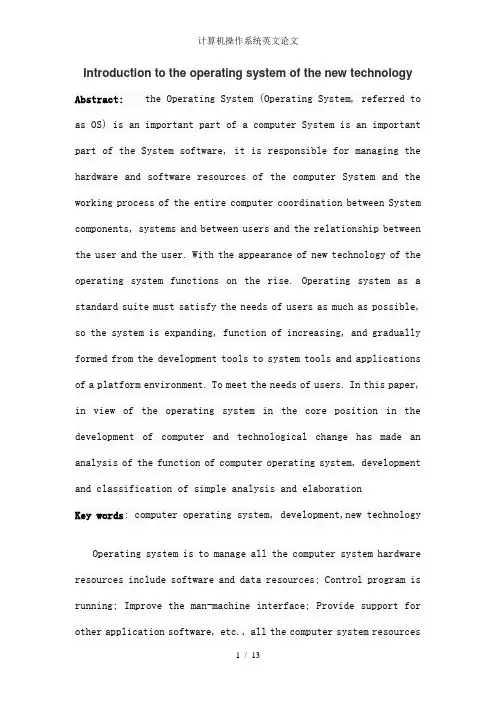
Introduction to the operating system of the new technology Abstract:the Operating System (Operating System, referred to as OS) is an important part of a computer System is an important part of the System software, it is responsible for managing the hardware and software resources of the computer System and the working process of the entire computer coordination between System components, systems and between users and the relationship between the user and the user. With the appearance of new technology of the operating system functions on the rise. Operating system as a standard suite must satisfy the needs of users as much as possible, so the system is expanding, function of increasing, and gradually formed from the development tools to system tools and applications of a platform environment. To meet the needs of users. In this paper, in view of the operating system in the core position in the development of computer and technological change has made an analysis of the function of computer operating system, development and classification of simple analysis and elaborationKey words: computer operating system, development,new technology Operating system is to manage all the computer system hardware resources include software and data resources; Control program is running; Improve the man-machine interface; Provide support for other application software, etc., all the computer system resourcesto maximize the role, to provide users with convenient, efficient, friendly service interface.The operating system is a management computer hardware and software resources program, is also the kernel of the computer system and the cornerstone. Operating system have such as management and configuration memory, decided to system resources supply and demand of priorities, control input and output devices, file system and other basic network operation and management affairs. Operating system is to manage all the computer system hardware resources include software and data resources; Control program is running; Improve the man-machine interface; Provide support for other application software, etc., all the computer system resources to maximize the role, to provide users with convenient, efficient, friendly service interface. Operating system is a huge management control procedures, including roughly five aspects of management functions, processes and processor management, operation management, storage management, equipment management, file management. At present the common operating system on microcomputer DOS, OS / 2, UNIX, XENIX, LINUX, Windows, Netware, etc. But all of the operating system with concurrency, sharing, four basic characteristics of virtual property and uncertainty. At present there are many different kinds of operating system, it is difficultto use a single standard unified classification. Divided according to the application field, can be divided into the desktop operating system, server operating system, the host operating system, embedded operating system.1.The basic introduction of the operating system(1)The features of the operating systemManagement of computer system hardware, software, data and other resources, as far as possible to reduce the work of the artificial allocation of resources and people to the machine's intervention, the computer automatically work efficiency into full play.Coordinate the relationship between and in the process of using various resources, make the computer's resources use reasonable scheduling, both low and high speed devices running with each other.To provide users with use of a computer system environment, easy to use parts of a computer system or function. Operating system, through its own procedures to by all the resources of the computer system provides the function of the abstract, the function of the formation and the equivalent of the operating system, and image, provide users with convenient to use the computer.(2)The development of the operating systemOperating system originally intended to provide a simple sorting ability to work, after updating for auxiliary more complex hardwarefacilities and gradual evolution.Starting from the first batch mode, also come time sharing mechanism, in the era of multiprocessor comes, the operating system also will add a multiprocessor coordination function, even the coordination function of distributed systems. The evolution of the other aspects also like this.On the other hand, on a personal computer, personal computer operating system of the road, following the growth of the big computer is becoming more and more complex in hardware, powerful, and practice in the past only large computer functions that it step by step.Manual operation stage. At this stage of the computer, the main components is tube, speed slow, no software, no operating system. User directly using a machine language program, hands-on completely manual operation, the first will be prepared machine program tape into the input, and then start the machine input the program and data into a computer, and then through the switch to start the program running and computing, after the completion of the printer output. The user must be very professional and technical personnel to achieve control of the computer.Batch processing stage. Due to the mid - 1950 - s, the main components replaced by the transistor computer, running speed hadthe very big enhancement, the software also began to develop rapidly, appeared in the early of the operating system, it is the early users to submit the application software for management and monitoring program of the batch.Multiprogramming system phase. As the medium and small-scale integrated circuit widely application in computer systems, the CPU speed is greatly increased, in order to improve the utilization rate of CPU and multiprogramming technology is introduced, and the special support multiprogramming hardware organization, during this period, in order to further improve the efficiency of CPU utilization, a multichannel batch system, time-sharing system, etc., to produce more powerful regulatory process, and quickly developed into an important branch of computer science, is the operating system. Collectively known as the traditional operating system.Modern operating systems. Large-scale, the rapid development of vlsi rapidly, a microprocessor, optimization of computer architecture, computer speed further improved, and the volume is greatly reduced, for personal computers and portable computer appeared and spread. Its the biggest advantage is clear structure, comprehensive functions, and can meet the needs of the many USES and operation aspects.2. New technology of the operating systemFrom the standpoint of the operating system of the new technology, it mainly includes the operating system structure design of the micro kernel technology and operating system software design of the object-oriented technology.(1) The microkernel operating system technologyA prominent thought in the design of modern operating systems is the operating system of the composition and function of more on a higher level to run (i.e., user mode), and leave a small kernel as far as possible, use it to complete the core of the operating system is the most basic function, according to the technology for micro kernel (Microkernel) technology.The microkernel structure(1) Those most basic, the most essential function of the operatingsystem reserved in the kernel(2)Move most of the functionality of the operating system intothe kernel, and each operating system functions exist in theform of a separate server process, and provide services.(3)In user space outside of the kernel including all operatingsystem, service process also includes the user's applicationprocess. Between these processes is the client/server mode.Micro kernel contains the main ingredient(1) Interrupt and the exception handling mechanism(2)Interprocess communication mechanisms(3)The processor scheduling mechanism(4)The basic mechanism of the service functionThe realization of the microkernelMicro kernel implementation "micro" is a major problem and performance requirements of comprehensive consideration. To do "micro" is the key to implementation mechanism and strategy, the concept of separation. Due to the micro kernel is the most important of news communication between processes and the interrupt processing mechanism, the following briefly describes the realization of both.Interprocess communication mechanismsCommunication service for the client and the server is one of the main functions of the micro kernel, is also the foundation of the kernel implement other services. Whether to send the request and the server reply messages are going through the kernel. Process of news communication is generally through the port (port). A process can have one or more ports, each port is actually a message queue or message buffer, they all have a unique port ID (port) and port authority table, the table is pointed out that this process can be interactive communications and which process. Ports ID and kernel power table maintenance.Interrupt processing mechanismMicro-kernel structure separation mechanism will interrupt and the interrupt processing, namely the interrupt mechanism on micro kernel, and put the interrupt handling in user space corresponding service process. Micro kernel interruption mechanism, is mainly responsible for the following work:(1) When an interrupt occurs to identify interrupt;(2) Put the interrupt signal interrupt data structure mapping tothe relevant process;(3) The interrupt is transformed into a message;(4) Send a message to the user space in the process of port, butthe kernel has nothing to do with any interrupt handling.(5) Interrupt handling is to use threads in a system.The advantages of the microkernel structure(1) Safe and reliableThe microkernel to reduce the complexity of the kernel, reduce the probability of failure, and increases the security of the system.(2) The consistency of the interfaceWhen required by the user process services, all based on message communication mode through the kernel to the server process. Therefore, process faces is a unified consistent processescommunication interface.(3) Scalability of the systemSystem scalability is strong, with the emergence of new hardware and software technology, only a few change to the kernel.(4) FlexibilityOperating system has a good modular structure, can independently modify module and can also be free to add and delete function, so the operating system can be tailored according to user's need.(5) CompatibilityMany systems all hope to be able to run on a variety of different processor platform, the micro kernel structure is relatively easy to implement.(6) Provides support for distributed systemsOperating under the microkernel structure system must adopt client/server mode. This model is suitable for distributed systems, can provide support for distributed systems.The main drawback of microkernelUnder the micro-kernel structure, a system service process need more patterns (between user mode and kernel mode conversion) and process address space of the switch, this increases costs, affected the speed of execution.3 .Object-oriented operating system technologyObject-oriented operating system refers to the operating system based on object model. At present, there have been many operating system used the object-oriented technology, such as Windows NT, etc. Object-oriented has become a new generation of an important symbol of the operating system.The core of object-oriented conceptsIs the basic idea of object-oriented to construct the system as a series of collections of objects. The object refers to a set of data and the data of some basic operation encapsulated together formed by an entity. The core of object-oriented concept includes the following aspects:(1) EncapsulationIn object-oriented encapsulation is the meaning of a data set and the data about the operation of the packaging together, form a dynamic entity, namely object. Encapsulated within the request object code and data to be protected.(2) InheritanceInheritance refers to some object can be inherited some features and characteristics of the object.(3) PolymorphismPolymorphism refers to a name a variety of semantics, or the same interface multiple implementations. Polymorphism inobject-oriented languages is implemented by overloading and virtual functions.(4) The messageNews is the way of mutual requests and mutual cooperation between objects. An object through the message to activate another object. The message typically contains a request object identification and information necessary to complete the work.Object-oriented operating systemIn object-oriented operating system, the object as a concurrent units, all system resources, including documents, process and memory blocks are considered to be an object, such as the operating system resources are all accomplished through the use of object services.The advantages of object-oriented operating system:(1)Can reduce operating system throughout its life period whena change is done to the influence of the system itself.For example, if the hardware has changed, will force the operating system also changes, in this case, as long as change the object representing the hardware resources and the operation of the object of service, and those who use only do not need to change the object code.(2)Operating system access to its resources and manipulation are consistent .Operating system to produce an event object, delete, and reference, and it produces reference, delete, and a process object using the same method, which is implemented by using a handle to the object. Handle to the object, refers to the process to a particular object table in the table.(3)Security measures to simplify the operating system.Because all the objects are the same way, so when someone tries to access an object, security operating system will step in and approved, regardless of what the object is.(4)Sharing resources between object for the process provides a convenient and consistent approach.Object handle is used to handle all types of objects. The operating system can by tracking an object, how many handle is opened to determine whether the object is still in use. When it is no longer used, the operating system can delete the object.ConclusionIn the past few decades of revolutionary changes have taken place in the operating system: technological innovation, the expansionof the user experience on the upgrade, application field and the improvement of function. As in the past few decades, over the next 20 years there will be huge changes in operating system. See we now use the operating system is very perfect. Believe that after the technology of the operating system will still continue to improve, will let you use the more convenient. Believe that the operating system in the future will make our life and work more colorful.。
有关计算机操作系统及应用的论文
有关计算机操作系统及应用的论文计算机操作系统是计算机中不可缺少的重要组成部分,是计算机的灵魂,没有操作系统,计算机的功能与价值就无法实现下面是店铺为大家整理的有关计算机操作系统及应用的论文,供大家参考。
有关计算机操作系统及应用的论文范文一:计算机操作系统的功能、发展及分类摘要:操作系统是统一管理计算机软件、硬件资源,合理组织计算机的工作流程,随着计算机技术的发展,人们对计算机的人性化、方便简洁提出了更高的要求,减少计算机占用的空间,缩小计算机的体积和重量,使计算机能更加方便地携带成为未来计算机发展的一个重要方向,以及嵌入式硬件技术的不断提高,使得越来越多的嵌入式产品需要嵌入式操作系统的支持。
关键词:计算机操作系统;发展;分类中图书分类号:TP316-4 文献标识码:A 文章编号:1006-8937(2012)32-0077-02操作系统是计算机系统中非常重要的部分。
对操作系统的研究与实现一直是计算机科学中挑战性和实用性完美结合的典范。
不同的计算机环境和不同的应用环境,需要不同的操作系统。
从个人计算机到大型计算机,从办公自动化到电子商务应用环境,从小型企业管理到大型企业的工业自动化控制,都需要有操作系统的支持。
操作系统的职责是管理计算机系统的硬件资源、软件资源,控制计算机的整个工作流程。
一方面,计算机系统结构和硬件技术的发展推动了操作系统的发展,因此而出现了多种形式、能够满足多种应用、资源利用效率不断提高的操作系统;另一方面,操作系统技术的不断发展又使得计算机的处理器、存储器等硬件资源的利用率得到了很大提高,能够不断满足用户方便、高效、快捷应用计算机的需求。
计算机系统由硬件和软件两部分组成。
对于这类操作系统相信用过电脑的人都不会陌生,这是全球最大的软件开发商——Microsoft(微软)公司开发的。
Microsoft公司的Windows系统在操作系统中占有绝对优势。
主流Windows系统都可以用在工作站中,如高Windows NT 4.0、Windows 9x/ME/XP、Windows 2000,以及最新的Windows 2003等。
计算机论文论文(精选5篇)
计算机论文论文(精选5篇)在日常学习、工作或生活中,大家总少不了接触作文或者范文吧,通过文章可以把我们那些零零散散的思想,聚集在一块。
那么我们该如何写一篇较为完美的范文呢?书读百遍,其义自见,下面是漂亮的小编给大伙儿收集整理的计算机论文论文(精选5篇),欢迎参考阅读。
计算机论文篇一有很多中学计算机方面的教师都抱怨学生对dos命令不感兴趣,认为计算机不能按照简单的“工具”去理解,认为要想掌握计算机的技术一定要打好基础。
对于类似这样的观点,笔者不敢苟同,互联网的普及就是由于简单易上手,试问每个使用计算机的人,有几个懂模糊数学和微积分的,如果一定要谈到基础,一定是从数学的计算和因解发端的。
要是那样,数码时代也不会到来了。
就像现在的风光摄影一样,在数码技术非常成熟的阶段,让每个摄影爱好者都了解相机的构造和光学原理没有必要,以前的测光技术都用测光表,现在可以auto 键一键解决。
可以说,在中学计算机教育的阶段,应用是一位的,对于计算机的基础语言学习,完全可以在大学阶段解决。
另外,对计算机教学的理解,不能简单的局限于技术性操作,要上升到学科和文化的高度,可以说,计算机已经成为各个学科和知识领域的重要媒介,麦克卢汉提出“媒介就是信息”,麦克卢汉以前,人们往往认为媒介只不过就是信息的载体,是信息传播的具体承载,但是他认为,媒介和信息是相互紧密连接的,没有媒介的渠道就谈不上信息的传播。
麦克卢汉发现了媒介的重要性,后工业时代的技术革命让,媒介引起了受众和信息之间的关系的微妙变化。
可以说媒介从来没有像今天这么重要,尤其是互联网这种媒介,可以说媒介已经在某种程度超越了内容本身,那么计算机作为互联网的子体,重要性不言而喻。
所以中学的计算机教学要让学生了解和适应这种媒介的具体形态和应用。
中学开设信息技术课的真正目的,在于使学生了解计算机的基本操作,,增强学生的对信息的处理能力和把自己已学的知识按照逻辑分析的方法进行信息整合。
计算机导论-论文-计算机操作系统
计算机导论-论文-计算机操作系统《计算机操作系统:从幕后到台前的奇妙之旅》在我们日常使用电脑或者手机的过程中,你有没有想过,是什么在背后默默工作,让我们能够轻松地打开软件、浏览网页、听音乐、玩游戏?其实,这都离不开一个关键的角色——计算机操作系统。
还记得我第一次接触计算机的时候,那是一台老旧的台式机,运行速度慢得像蜗牛。
当我满怀期待地按下电源键,等待了好久好久,才终于看到那个陌生又神秘的界面。
我小心翼翼地移动鼠标,点击着各种图标,却经常因为不熟悉而弄得手忙脚乱。
当时的我,根本不知道这背后有一个强大的操作系统在支撑着这一切。
计算机操作系统就像是一个超级管家,它管理着计算机的硬件和软件资源,让它们能够和谐共处,高效地为我们服务。
它负责处理内存分配,决定哪些程序可以使用多少内存,就像是在一个拥挤的房间里合理安排每个人的床位,确保大家都能有地方休息。
它还管理着 CPU的调度,决定哪个程序可以先运行,哪个需要等待,就像在一个繁忙的厨房中,安排厨师们依次烹饪不同的菜肴,保证整个流程有条不紊。
操作系统中的文件系统也非常重要。
想象一下,你的电脑里存储着各种各样的文件,有照片、文档、音乐、视频等等,如果没有一个良好的文件系统来组织和管理它们,那简直就是一场灾难。
就好比一个杂乱无章的图书馆,你想要找一本书,却根本无从下手。
而操作系统的文件系统就像是一位优秀的图书管理员,将每一本书都准确地分类、编号、存放,让你能够轻松找到你需要的东西。
说到这里,不得不提一下 Windows 操作系统。
相信很多人都对它非常熟悉。
Windows 以其直观的图形界面和易用性,赢得了广大用户的喜爱。
还记得在学校的计算机课上,老师教我们如何使用 Windows 系统来完成各种任务,从简单的文件操作到复杂的软件安装。
那时候,每次成功完成一个操作,都让我感到无比兴奋。
而在服务器领域,Linux 操作系统则是当之无愧的霸主。
它以其稳定性和安全性,被广泛应用于各种大型服务器和数据中心。
计算机操作系统论文
计算机操作系统论文计算机操作系统是管理计算机硬件与软件资源的程序,是计算机系统的内核与基石。
它负责控制和协调计算机的各种活动,使得计算机能够高效、稳定地运行,并为用户提供一个方便、友好的操作环境。
一个典型的计算机操作系统具有多个重要的功能。
首先是进程管理,它负责创建、调度和终止进程,确保多个程序能够并发运行,充分利用计算机的资源。
通过合理的进程调度算法,操作系统可以决定哪个进程在何时获得 CPU 时间,以提高系统的整体性能和响应能力。
内存管理是另一个关键功能。
操作系统需要有效地分配和回收内存空间,以满足不同程序的需求。
它要确保各个程序之间的内存隔离,防止一个程序的错误访问影响到其他程序的正常运行。
同时,还需要实现虚拟内存技术,让计算机能够运行比实际物理内存更大的程序。
文件系统管理也是操作系统的重要职责。
它负责组织和存储计算机中的文件和数据,提供文件的创建、删除、读取和写入等操作。
文件系统需要考虑数据的存储效率、数据的安全性和可靠性,以及文件的快速检索和访问。
设备管理则负责控制和协调计算机与外部设备的通信。
包括设备的驱动程序、设备的分配和释放,以及输入输出操作的控制。
操作系统需要能够处理各种不同类型的设备,并为用户提供统一的设备访问接口。
在众多操作系统中,Windows 操作系统是最为广泛使用的个人计算机操作系统之一。
它具有图形化的用户界面,易于操作和学习。
Windows 不断更新和改进,从早期的 Windows 95 到现在的 Windows10 和 Windows 11,在性能、安全性和功能上都有了显著的提升。
其强大的兼容性使得各种软件和硬件都能够在 Windows 平台上运行。
Linux 操作系统则以其开源、稳定和安全的特点在服务器领域占据重要地位。
许多大型网站和企业级应用都运行在 Linux 服务器上。
由于其开源的特性,开发者可以根据自己的需求对 Linux 进行定制和优化,从而满足各种特殊的应用场景。
- 1、下载文档前请自行甄别文档内容的完整性,平台不提供额外的编辑、内容补充、找答案等附加服务。
- 2、"仅部分预览"的文档,不可在线预览部分如存在完整性等问题,可反馈申请退款(可完整预览的文档不适用该条件!)。
- 3、如文档侵犯您的权益,请联系客服反馈,我们会尽快为您处理(人工客服工作时间:9:00-18:30)。
计算机操作系统的发展——浅谈操作系统的现状与发展趋势摘要:操作系统(Operating System,简称OS)是计算机系统的重要组成部分,是一个重要的系统软件,它负责管理计算机系统的硬、软件资源和整个计算机的工作流程,协调系统部件之间,系统与用户之间、用户与用户之间的关系。
随着操作系统的新技术的不断出现, 功能不断增加。
操作系统作为一个标准的套装软件必须满足尽可能多用户的需要,于是系统不断膨胀,功能不断增加,并逐渐形成从开发工具到系统工具再到应用软件的一个平台环境。
更能满足用户需求。
本文主要针对操作系统在计算机发展中的核心地位和技术变革作出了分析,同时对计算机操作系统的功能,发展和分类做了简单的分析和阐述,以及对计算机未来发展趋势做了一个预测。
关键词:计算机操作系统发展历程新技术发展趋势计算机操作系统所处的地位及效用:操作系统是管理计算机系统的全部硬件资源包括软件资源及数据资源;控制程序运行;改善人机界面;为其它应用软件提供支持等,使计算机系统所有资源最大限度地发挥作用,为用户提供方便的、有效的、友善的服务界面。
操作系统是一个管理电脑硬件与软件资源的程序,同时也是计算机系统的内核与基石。
操作系统身负诸如管理与配置内存、决定系统资源供需的优先次序、控制输入与输出设备、操作网络与管理文件系统等基本事务。
操作系统是管理计算机系统的全部硬件资源包括软件资源及数据资源;控制程序运行;改善人机界面; 为其它应用软件提供支持等,使计算机系统所有资源最大限度地发挥作用,为用户提供方便的、有效的、友善的服务界面。
操作系统是一个庞大的管理控制程序,大致包括 5 个方面的管理功能:进程与处理机管理、作业管理、存储管理、设备管理、文件管理。
操作系统的分类:目前微机上常见的操作系统有DOS、OS/2、UNIX、XENIX、LINUX、Windows、Netware 等。
移动端常见的操作系统有BlackBerry、Windows Mobile、IOS以及大多数基于Linux系统的移动平台,如android、Mameo、Symbian、Palm 等。
但所有的操作系统具有并发性、共享性、虚拟性和不确定性四个基本特征。
目前的操作系统种类繁多,很难用单一标准统一分类。
根据应用领域来划分,可分为桌面操作系统、服务器操作系统、主机操作系统、嵌入式操作系统。
一、操作系统的基本介绍(一)操作系统的功能1、管理计算机系统的硬件、软件、数据等各种资源,尽可能减少人工分配资源的工作以及人对机器的干预,发挥计算机的自动工作效率。
2、协调各种资源使用过程中的关系,使得计算机的各种资源使用调度合理, 高速设备与低速设备运行相互配。
3、为用户提供使用计算机系统的环境,方便使用计算机系统的各部件或功能。
操作系统通过自己的程序,将计算机系统的各种资源所提供的功能抽象,形成与之等价的操作系统的功能,并形象地表现出来,提供给用户方便地使用计算机。
(二)操作系统的发展历程操作系统之本意原为提供简单的工作排序能力,后为辅助更新更复杂的硬件设施而渐渐演化。
从最早的批次模式开始,分时机制也随之出现,在多处理器时代来临时,操作系统也随之添加多处理器协调功能,甚至是分布式系统的协调功能。
其他方面的演变也类似于此。
另一方面,在个人电脑上,个人电脑之操作系统因袭大型电脑的成长之路,在硬件越来越复杂、强大时,也逐步实践以往只有大型电脑才有的功能。
1、手工操作阶段。
特点:计算机主要元器件是电子管,速度慢,无任何软件,更无操作系统,编译语言是机器语言。
2、批处理阶段。
特点:计算机主要元器件晶体管,运行速度提高,出现早期的操作系统,即早期的对用户提交的程序进行管理的监控程序和批处理软件。
3、多道程序系统阶段。
特点:中、小规模的集成电路在计算机系统中广泛应用,CPU的运行速度大幅提高随着中、小规模的集成电路在计算机系统中的广泛应用,CPU 的运动速度大大提高,为了提高CPU的利用效率,出现了多道批处理系统、分时系统等等CPU 的利用率,引入了多道程序设计技术, 并出现,从而产生了更加强大的监管程序,并迅速发展成为计算机学科的一个重要分支,即操作系统。
4、现代操作系统阶段。
特点:大规模、超大规模集成电路急速的迅速发展,出现了微处理器,使得计算机的体系结构更加优化,计算机的运行速度进一步提高,而体积却大大减少,面向个人的计算机和便携式计算机出现并普及。
它的最大优点是结构清晰、功能全面、可以适应多种用途的需要并且操作使用方面。
二、操作系统新技术(一)微内核操作系统技术现代操作系统设计中的一个突出思想是把操作系统中更多的成分和功能放到更高的层次(即用户模式)中去运行,而留下一个尽量小的内核,用它来完成操作系统最基本的核心功能,称这种技术为微内核(Microkernel)技术。
1、微内核结构(1)把那些最基本、最本质的操作系统功能保留在内核中;(2)把大部分操作系统的功能移到内核之外,并且每一个操作系统功能均以单独的服务器进程形式存在,并提供服务。
(3)在内核之外的用户空间中包括所有操作系统服务进程,也包括用户的应用进程。
这些进程之间是客户/服务器模式。
3、微内核包含的主要成分(1)中断和异常处理机制;(2)进程间通信机制;(3)处理机调度机制;(4)有关服务功能的基本机制。
4、微内核的实现微内核实现中的一个主要问题是“微” 和性能要求的综合考虑。
要做到“微” 的关键是实现机制和策略分离的概念。
5、进程间通信机制为客户和服务器提供通信服务是微内核的主要功能之一,也是内核实现其他服务的基础。
无论是发送请求消息和服务器的回答消息都是要经过内核的。
6、中断处理机制微内核结构中将中断机制与中断处理分离,即把中断机制放在微内核中,而把中断处理放到用户空间相应的服务进程中。
7、微内核结构的优点(1)安全可靠微内核降低了内核的复杂度,减少了发生故障的概率,也就增加了系统的安全性。
(2)一致性的接口当用户进程提出服务要求时,均是以消息通信方式经由内核向服务器进程提出的。
因此,进程所面对的是一个统一一致的进程通信接口方式。
(3)系统的可扩充性系统可扩充性强,随着新硬件与新软件技术的出现,只需对内核做很少的修改。
(4)灵活性操作系统具有良好的模块化结构,可以独立地对模块进行修改,也可随意对功能进行增加和删除,因此操作系统可以按用户的需要进行剪裁。
(5)兼容性许多系统都希望能运行在多种不同的处理器平台上,这在微内核结构下是比较容易实现的。
(6)提供了对分布式系统的支持在微内核结构下操作系统必须采用客户/服务器模式。
这种模式适合于分布式系统,可以对分布式系统提供支持。
8、微内核的主要缺点在微内核结构下,一次系统服务过程需要更多的模式(在用户态和核心态之间)转换和进程地址空间的开关,这就增加开销,影响了执行速度。
(二)面向对象操作系统技术面向对象操作系统是指基于对象模型的操作系统。
目前,已有许多操作系统采用了面向对象技术,如Windows NT 等。
面向对象已成为新一代操作系统的一个重要标志。
1、面向对象的核心概念面向对象的基本思想是把要构造的系统表示成一系列对象的集合。
其中的对象是指把一组数据和该数据的一些基本操作封装在一起所形成的一个实体。
面向对象的核心概念包括以下几个方面:(1)封装在面向对象中,封装的含义是将一个数据集和与这个数据有关的操作封装在一起,形成一个能动的实体,即对象。
封装要求对象内部的代码和数据受保护。
(2)继承继承是指一些对象可以继承另一些对象的功能和特征。
(3)多态性所谓多态性是指一个名字多种语义,或相同界面多种实现。
多态性在面向对象语言中是由重载和虚函数来实现的。
(4)消息消息是对象之间相互请求和相互合作的途径。
一个对象通过消息激活另一对象。
消息中一般包含有请求对象的标识和完成该工作所必须的信息。
2、面向对象操作系统在面向对象操作系统中,对象作为一种并发单位,所有系统资源,包括文件、进程、内存块等都被认为是一种对象,对系统资源的所有操作都是通过使用对象服务来完成的。
面向对象操作系统的优点:(1)可以减少操作系统在其整个生命期内所做修改时对系统本身的影响。
例如,如果硬件发生了变化,将迫使操作系统也作出改动,在这种情况下只要改变代表该硬件资源的对象和对该对象进行操作的服务即可,而那些仅使用该对象的代码则不需改变。
(2)操作系统对其资源的访问和操纵是一致的。
操作系统生成、删除和引用一个事件对象,与它生成、删除和引用一个进程对象采用相同的方法,即都是通过使用对象句柄来实现的。
所谓对象句柄,是指进程指向的一个特定对象表中的表项。
(3)操作系统的安全措施得以简化由于所有对象都采用同样的保护方式,那么当某人试图访问一个对象时,安全系统就介入并核准操作,而不管这个对象是什么。
(4)对象为进程之间分享资源提供了方便和一致性的手段。
对象句柄被用来处理所有类型的对象。
操作系统可以通过跟踪一个对象有多少个句柄被打开,来决定该对象是否仍在使用中。
当它不再使用时,操作系统就可以删除该对象。
(三)嵌入式操作系统嵌入式系统是以应用为中心,软硬件可裁减的,适用于对功能、可靠性、成本、体积和功耗等综合性要求严格的专用计算机系统。
它具有软件代码小、自动化程度高和响应速度快等特点,特别适合于要求实时和多任务的体系。
目前,专用操作系统均属于商业化产品并且价格昂贵。
由于它们各自的源代码不公开,使得每个系统上的应用软件与其它系统都无法兼容。
这种封闭性还导致了商业嵌入式系统在对各种设备的支持方面存在很大的问题,使得它们的软件移植变得很困难。
Linux^8作为开源系统,不会出现这样的问题。
因此,除了智能数字终端领域以外,Linux在移动计算平台、智能工业控制和金融业终端系统,甚至军事领域也都有着广泛的应用前景。
(四)可扩展操作系统现代操作系统在内涵发生变化的同时,外延也在悄然发生变化。
正是由于微内核技术的使用,使操作系统在保持核心功能的基础上能够灵活地结合各种服务及应用,这就是所谓的可扩展操作系统。
这种外延和扩展不仅体现在用户应用层,还体现在硬件层。
实际上,未来的操作系统在计算机体系结构中将向硬件层和应用层两个方向延伸。
例如,现代操作系统可以将操作系统的部分功能交给硬件实现,即将一部分功能模块采用软件固化技术固化在相关芯片上,这种含有系统软件和应用软件的专用芯片无疑是未来操作系统的发展方向。
(五)可信操作系统随着网络安全问题日益严峻,人们对平台安全性的认识和要求也越来越迫切。
而自从微软发布Vista操作系统以来,人们开始看到安全可信的操作系统离普通用户越来越近。
近年来可信计算技术被选择用来从根本上解决个人电脑的脆弱性,并得到快速发展。
随着微软Vista的部署,市场对高可信操作系统的理解和需求将逐步扩大。
